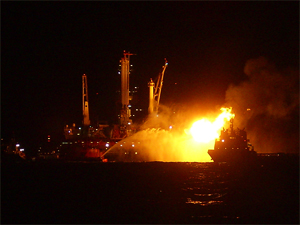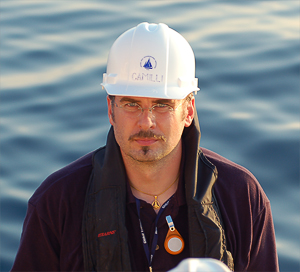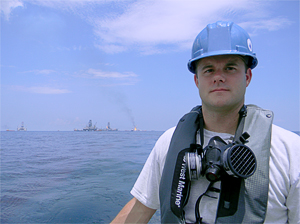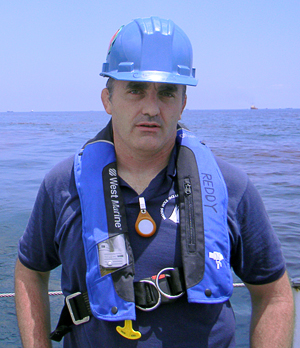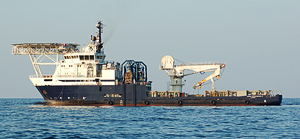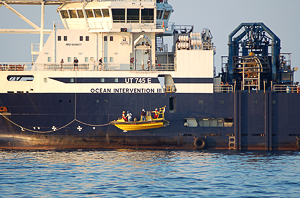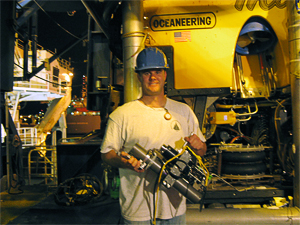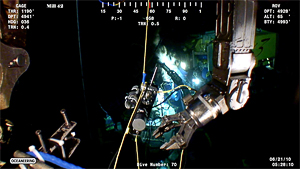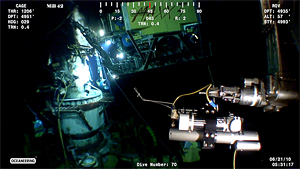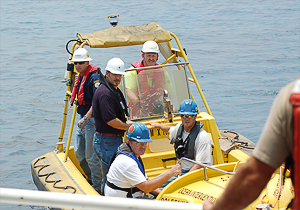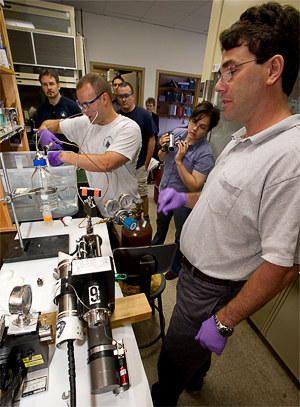By Lonny LippsettSource: Oceanus MagazineThe prize they coveted amounted to nothing more than about four gallons of natural gas and less than a half-cup of oil. Where it came from, however, made it unique. Scientists at Woods Hole Oceanographic Institution (WHOI) sought the definitive sample of petroleum from the Macondo well beneath the ill-fated Deepwater Horizon drilling rig—straight out of the gushing maw of the broken riser pipe on the seafloor. They had a one-of-a-kind instrument that they believed could do the job and mobilized several times to use it at the stricken well, but had been denied access. Then on June 20, 2010, while three WHOI researchers were in the midst of other research in the Gulf of Mexico aboard the research vessel Endeavor, they were notified that U.S. Coast Guard officials had arranged for them to be transferred that evening via a small fastboat to a massive vessel operating directly above the spewing pipe. The sun was setting as WHOI researchers Rich Camilli, Chris Reddy, and Sean Sylva, and USCG Lt. Jarrett Parker were hoisted aboard the 297-foot Ocean Intervention III. They were given a 12-hour window to complete their mission before personnel aboard the OI III would have to resume other operations related to the spill. “We had one shot to make this happen,” Reddy said. Plenty could go wrong, and plenty did, during what the three researchers now refer to as “The Night of the Caper.” Working under pressureScientists and officials both craved a sample of Macondo petroleum taken right as it emerged from its subseafloor reservoir and before the oil and gas separated into its many constituent chemical compounds. Some of those compounds were swept into undersea plumes or deposited on the seafloor. Others floated to the surface, evaporated into the atmosphere, or were consumed by microbes. With a pristine sample, scientists would be able to tell how much of the leaking fluid was oil and how much was natural gas, which would help officials calculate more accurately the total amount of oil spilled. The sample would also provide a unique chemical fingerprint of the oil, which officials could use to determine whether the Macondo well was the source of any oil found on the seafloor or on a beach. And that same fingerprint would give scientists the chance to learn where the released oil and gas went after it entered the ocean, why it went there, what chemical transformations occurred along the way, and how microbes acted on it. To get a sample of the dark fluid erupting from the broken pipe, WHOI scientists proposed using an instrument developed to sample hydrothermal vents—volcanic undersea areas where hot fluids spew like geysers from the seafloor. The erupting oil, Sylva said, “was just a bigger, stickier, messier hydrothermal vent.” The instrument, developed by marine geochemist Jeff Seewald and engineers at WHOI, is called the isobaric gas-tight sampler, or IGT. It could capture the critical sample and maintain its composition as it was brought up from the high pressure of the deep sea. “The pressure on the bottom was close to 2,200 pounds per square inch,” Sylva said. Such high pressure confines the gas in a small volume, but as the sample is brought up to the surface, the pressure goes down and the gas rapidly expands. “You have the potential, essentially, for a bomb,” Sylva said. “The genius of these samplers is that they have enough structural integrity to contain that pressure safely.” But ship crews were unfamiliar with the IGT and procedural concerns had prevented the samplers from being allowed aboard the response vessels. In late May, Camilli had been aboard Ocean Intervention III on another Coast Guard-sponsored project to measure the rate of fluids flowing out of the broken pipe using a new acoustic technique. He had shipped down IGTs to take a sample at the same time but was denied permission to use them. But Camilli persisted. “And we also had the backing again of the U.S. Coast Guard to help us take care of our unfinished business,” he said. Flames and unfamiliarityCamilli, Reddy, and colleagues were back in the Gulf in mid-June aboard the Endeavor in the middle of another research mission to search for suspected subsea plumes from the oil spill. The Coast Guard got clearance for Endeavor to enter an area known as the “exclusion zone,” where only ships that were critical for well-containment operations were allowed. Coast Guard officials also arranged the fastboat transfer to the Ocean Intervention III. In effect, the scientists made the highly unusual move of shoehorning an overnight commando-style scientific mission in the midst of another one. “I would have never thought of doing that,” Reddy said. “That was testament to Rich’s tenacity and the help of the Coast Guard.” The scene aboard the OI III was atypical for academic oceanographers. “We were in the middle of something apocalyptic,” Reddy said. “The ship was between two others that were burning off natural gas from the blowout. You had these two flames coming out like the nose of a dragon.” “The sound from these gas flare-offs was deafening,” Sylva said. “We had to wear ear protection. We could also feel the heat from these flare-offs—we were that close. It was such a surreal environment, with ships all around you, and flames all around you, and bright lights and helicopters.” In the midst of this turmoil, “we met with an unbelievably talented team of people who work for a company called Oceaneering, which operated the ship and its remotely operated vehicles for the oil industry,” Reddy said. “But there were challenges because, you know, we had never worked with them. I mean, it’s like cooking dinner in somebody else’s kitchen. We didn’t know where the forks were.” The Oceaneering personnel were skilled at using underwater remotely operated vehicles, or ROVs, Sylva said, but they never used an instrument like the IGT before. For one thing, to control the IGT samplers' operations from the ship, the scientists needed to maintain communication links with them after the ROV carried the samplers down to the leaking pipe. “We spoke sort of different (technical) languages, and we had to work with the ROV guys to interface our cables with their ROV,” Sylva said. With the clocking ticking, the new partners had to adapt and find quick fixes. “With every problem we encountered, Camilli would come up with a solution when every other attempt had failed,” Sylva said. “At one point, we couldn’t get the samplers to ‘talk’ to us,” Reddy said, “so Camilli says, ‘Put out your hand,’ and takes out his jackknife, and he’s scraping some wires and wrapping them together while I’m holding them in my hand.” “The whole Oceaneering ROV team,” Sylva said, “couldn't have been more helpful—from getting on the ship and setting up the electrical connections, to working with us on how they go through their dive, so that we could adapt and set up our samplers and make it happen.” The longest 90 secondsFinally, the IGTs were ready for the ROV. But Oceaneering’s ROV was not ideally suited for them. Made from solid titanium to withstand pressure, the IGTs are heavy (about 40 pounds)—and expensive (at least $40,000). “The ROVs that we usually use have scientific baskets, so the IGTs are nice and secure and snug in a basket,” Sylva said. The OI III’s ROVs did not have baskets, so the team put the IGTs in the claws of the ROV’s manipulator arm. On the first dive attempt, the ROV’s power failed; the claw opened and dropped the samplers. The power failure shut off the ROV’s cameras, so the WHOI team wasn’t even sure the IGTs hadn’t been lost until the ROV came back on deck. “Luckily, the ROV guys were excellent, and they planned for this,” Sylva said. They had tied ropes to the samplers, so they wouldn’t fall to the bottom of the sea. On the next attempt, the ROV team looped a rope around metal struts on the ROV. “The IGT was dangling by rope from these pieces of metal, because that’s the only way we had to attach them,” Sylva said. “I was a nervous wreck,” Sylva said. “When the ROV was descending to the bottom, I was incessantly talking to the samplers, to make sure I still had communication with them.” “I would say that Sean lost five years of his life in that operation—he certainly had that look on him,” Reddy said. “It’s because he is so conscientious. I mean, Sean embodies the WHOI technical staff—the unbelievable, comprehensive breadth of their technical skills, and the fact that they care so much.” “It was nearing the end of our 12-hour window by the time the ROV reached the seafloor and its cameras began relaying images back to the ship,” Reddy said. “It was pretty amazing when the lights turned on and all of a sudden you saw this bubbling cauldron.” “It was eye-opening to see it in high-definition, to see how much oil was really coming out,” Sylva said. “The oil's coming from deep in a reservoir, so it's going to be warm compared to the seawater,” he said. The IGT has a protruding snorkel with a thermocouple that measures temperature. The scientists needed to put the snorkel into the billowing black jet of petroleum and aim for an area with the highest temperature. That would ensure that they collected a pristine, undiluted sample, before any cooler seawater mixed in. “The ROV operators’ job was to put the sampler where we wanted the sample to be taken,” Sylva said. “Normally they do brute force stuff like cutting pipes and welding—they really don't have to perform fine motor movements. So they were excited to work with us, because they really got to show off their manipulator arm skills. We used the thermocouple to guide where the sampler should go and told them to move a little to the left, a little bit to the right, back, forward, up, down …” As Oceaneering ROV pilots guided the snorkel into the jet, Sylva’s eyes focused keenly on the restless readings from the thermocouple on the IGT, which dangled from a rope from the ROV. He gauged whether the snorkel had hit an area with the highest temperature, or whether another manipulation might obtain an even higher reading and a better sample. “We were saying, ‘Omigosh, have we hit the hot spot’—the area where it’s pure oil and gas?” Reddy said. Sylva’s finger was poised on the trigger to open the IGT’s valve and let in the sample. Once it opened, that was it. He would have no second chance. Sometime in the pre-dawn hours, with the thermocouple registering 221°F, he pressed the button to open the valve. “It was among the longest 90 seconds I ever experienced,” Reddy said. “We could tell that the valve opened and closed properly,” he said, “It looked as though we got a good sample, but we weren't going to be a hundred percent sure until we opened it back at Woods Hole.” Getting it and then getting it out“Once the samplers came up on deck,” Sylva said, “they were never out of either our sight, or Lt. Parker's sight. We put plugs in all the holes, so if, for some reason, it didn't seal, or the seal let go, these plugs would also keep the pressure in the samplers. We put evidence tape over every possible spot where the samplers could be taken apart.” The samplers were handed over to Lt. Parker, who left the OI III immediately via a work boat back to shore. The samplers never left Lt. Parker’s side as he and Lt. Joseph Kusek drove them to WHOI. The chain of custody remained unbroken, as he handed them off a few days later, still sealed, to Bob Nelson, a research specialist in Reddy’s lab, who signed for them and put them in a refrigerator under lock and key. By the time Lt. Parker left the OI III with the samplers, it was morning, and the sleepless WHOI scientists went to get something to eat. “There wasn’t much high-fiving,” Reddy said, “because now we had to figure out how to get the oil and gas out of the samplers, which hadn’t been designed to separate oil and gas. I remember sitting and eating breakfast and taking a paper placemat and drawing a schematic diagram about how we were going to separate and measure the oil and gas.” “Jeff and I and Chris thought long and hard and came up with a few different ideas of how we were going to do this separation,” Sylva said. “Once we finally decided on a design, I built it.” A few weeks passed as Reddy and Camilli completed their other research aboard Endeavor and returned to WHOI. On July 15, 2010, they joined Sylva and Seewald, who were ready to try the extraction. A crowd filled the narrow aisles in Reddy’s laboratory, including researchers, observers from the Coast Guard, and photographers to document the event. “That was a crowning moment,” Sylva said. “That was when we were going to know if the sample we took actually contained any oil and gas, or if it just contained seawater.” Tubes snaked out of the IGT. Seewald opened a valve. At near sea level, highly compressed natural gas eased out of the sampler, expanded, and filled a bag. Then inky black oil began to drip into a glass beaker. The scientists had obtained their precious sample, which would provide the foundation for so much valuable information. The Night of the Caper had been successful. “We were a strong team,” Reddy said. “Lt. Parker crucially facilitated so many of the logistics. Sean had extensive experience operating IGTs. I knew something about oil. Camilli had amazing knowledge of robotics and electronics. He also had worked before with the oil industry and with people aboard the OI III, and he was a great team leader." "We couldn't have done this sampling without all of us,” Sylva said. “If one of us wasn't there, it probably wouldn't have happened. It was a collective effort. It made me proud to be a WHOI technical staffer and be involved with something like this. It was an exciting experience. From a scientific perspective, we did something we had never done, in an environment we had never worked in before. And it was something that was so socially relevant.” Sylva paused, and then he added: “I hope to not have to do it again.” The research of the WHOI team was funded by the National Science Foundation and the United States Coast Guard. Originally published: July 21, 2011 Last updated: September 14, 2017 | ||||||||||||||||||||||||||||||||||||||
Copyright ©2007 Woods Hole Oceanographic Institution, All Rights Reserved, Privacy Policy. | ||||||||||||||||||||||||||||||||||||||

